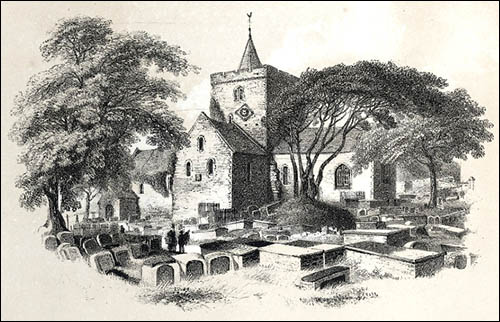St Padarn’s Church, Llanbadarn Fawr
This was one of the most important early Christian sites in Wales. The drawing from c1850 by James William Giles is shown here courtesy of the National Library of Wales.
A monastery was founded here by St Padarn in the sixth century. The site was later damaged by Vikings. The building we see here today, including its imposing tower, largely dates from the 13th century but with later additions and alterations. When the church needed repairs in the 1870s, so many changes were proposed that the Arts & Crafts designer William Morris pleaded with the vicar for moderation.
 Padarn came to Wales from Brittany. More than 100 monks were attracted to his monastery here. He sought to convert heathen rulers including Maelgwn Gwynedd, who eventually died of a plague despite locking himself in a church as protection against it. Padarn is said to have proved his innocence, after being falsely accused by Maelgwn, by plunging his hand into boiling water and removing it unscathed. Padarn may not have been the same saint as the dedicatee of St Padarn’s Church, Llanberis.
Padarn came to Wales from Brittany. More than 100 monks were attracted to his monastery here. He sought to convert heathen rulers including Maelgwn Gwynedd, who eventually died of a plague despite locking himself in a church as protection against it. Padarn is said to have proved his innocence, after being falsely accused by Maelgwn, by plunging his hand into boiling water and removing it unscathed. Padarn may not have been the same saint as the dedicatee of St Padarn’s Church, Llanberis.
Llanbadarn Fawr parish was once the biggest in Wales. In the 11th century the church was a centre of teaching and writing. Its authors, including Sulien and Rhygyfarch, compiled significant records of the early church in Wales.
According to Gerald of Wales, the church was once a cathedral. He and the Archbishop of Canterbury spent a night here in 1188 while touring Wales to recruit for the third crusade. Many men enlisted in the morning. Gerald noted in his journal that the church, like many others in Wales and Ireland, was in the care of a so-called abbot who had not been ordained. These abbots had grabbed power and land. He also wrote that a visitor from Brittany, earlier that century, was amazed to see Llanbadarn’s “abbot” arrive to lead mass wearing ordinary clothes (not church vestments) and carrying a spear!
The great poet Dafydd ap Gwilym (d.1370) was probably born in the parish. In his poem Merched Llanbadarn (“The girls of Llanbadarn”), he describes ogling a female member of the congregation in the church, and curses the parish’s womenfolk for spurning his advances!
In August 1485 Henry Tudor and his fledgling army reputedly passed through Llanbadarn while marching from Pembrokeshire to the Battle of Bosworth, where victory resulted in his coronation as King Henry VII.
William Morgan was vicar here in the 16th century. He went on to complete the first translation of the Bible into Welsh, a feat commemorated outside St Asaph Cathedral. A copy of the original 1588 Bible is kept in St Padarn’s Church.
Also inside are two ancient stone crosses, moved here in 1916. They were probably used by Christians from around the 10th century, but may have been pagan objects originally. The stone arch above the south door is thought to have come from Strata Florida Abbey.
Among the many memorials inside the church is one to Lewis Pugh Evans (1881-1962), who was born in Abermad and received the Victoria Cross for his bravery and leadership in the Battle of Passchendaele in October 1917.
The church’s oldest bell dates from 1749. The original peal of six bells was increased to eight in 1885 and to 10 in 2001.
Postcode: SY23 3QZ View Location Map



